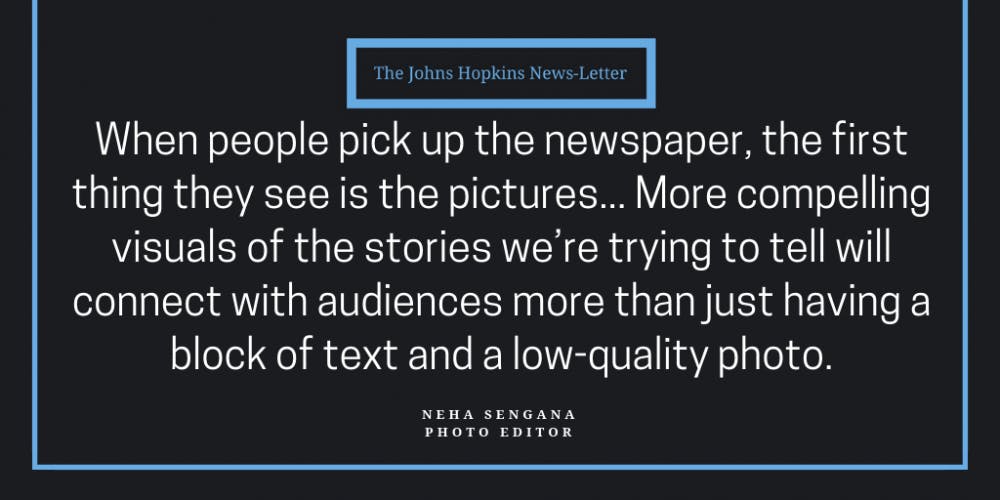
Let me set a scene:
It’s late on a Wednesday night at the Gatehouse, the little cottage at the bottom corner of campus where The News-Letter happens. News editors have just begun to lay out their pages, and have realized that they don’t have enough photos. Let the brainstorming begin — run across campus to snap a quick pic of such-and-such building even though it’s dark. Pester writers to see if they took any photos. When in doubt, use a file photo of the Gilman clock tower.
Wednesday nights at The News-Letter are pretty hectic. To make sure the paper comes out Thursday morning, editors spend the evening prior editing articles, laying out pages and adding photos or other visual design elements. At least three people read over each piece before print, sometimes more. This isn’t a quick process — it’s a 12 hour affair. Even when everything runs smoothly, it feels chaotic.
Somewhere in that chaos, editors push photos to the bottom of the priority pile. I was a News Editor once, and I remember the relief of getting even the blurriest iPhone photos on more desperate weeks. Why didn’t we partner more proactively with the paper’s photo staff? Well we had enough on our plates trying to make sure the words were there. We didn’t worry much about photos until we were trying to balance our pages.
Given my past role in undervaluing our photo staff, I asked News-Letter Photography Editors Eda Incekara and Neha Sangana to expand on the added dimension that high-quality photos can add to a piece.
“When people pick up the newspaper, the first thing they see is the pictures,” Sangana said. “More compelling visuals of the stories we’re trying to tell will connect with audiences more than just having a block of text and a low-quality photo.”
I can’t speak for other sections, but looking back through the paper it’s hard not to notice the abundance of online photos (don’t worry, it’s not stealing — the photos are marked for reuse). Even this past week, the A1 photo featured a concert in D.C. that Arts reviewed. Now, I’m all for representing other sections on the front page. Still, with headlines on Blackboard’s preferred names change, the relocation of the Student Disability Services office and free laundry for underclassmen, I wasn’t expecting to see dodie.
Using online photos has been normalized because it’s easier and more convenient, but also because some sections don’t include as much local coverage — for film reviews, personal columns, op-eds on national policy or global scientific discoveries, editors aren’t used to thinking creatively about how to engage the paper’s photo staff.
This is not by any means an issue specific to The News-Letter. Newspapers around the world have struggled to adapt to the changing demands of consumers in the technological age, gutting newsrooms under ever-mounting pressure to cut costs. Photojournalists are often the first to go and the hardest hit.
Luckily (in one sense, at least) nobody at The News-Letter gets paid. Editors don’t have to worry about budgeting in quite the same way, but the paper’s photo staff faces challenges of its own. I asked Incekara and Sangana to unpack their plans to address those challenges.
For them, a big priority is building community — creating an environment where interested photographers can come together to feel supported and valued. Incekara elaborated:
“This year I want to start an active conversation with the photographers every week and actually have them know each other,” she said. “That was something that was lacking when I was a photographer.”
Building a stronger staff can give the section more freedom to explore creative forms of visual storytelling. Striking visuals to make our coverage of campus events stand out, curated series paired with columns that complement the writer’s inner voice — these add a layer of color and texture that can help The News-Letter better represent Hopkins students. We’re not talking about reinventing the wheel, but editors should work proactively with this year’s photo staff to prioritize visual media as a form of storytelling.
As the semester has gotten underway, Incekara and Sangana have opened up communication with other section editors to start those collaborations. I’d love to see more dynamic front page visuals, long-form layouts that incorporate photos more prominently in print and online and collaborations with the Social Media Editor to feature more student work on the paper’s newly revived Instagram.
Both Incekara and Sangana also said they would prioritize curating photo essays this year that reflect students’ unique perspectives on campus and the surrounding Baltimore neighborhoods.
“Media plays a large role in influencing how people feel about the city they’re in,” Sangana said. “Pictures can really highlight the beauty that Baltimore has.”
And my fellow readers — what’s your role in this? Well, if you dabble every now and again in photography but can’t commit to joining the staff, why not try your hand at publishing a photo essay to show off your perspective?
If you find yourself snapping photos while exploring the beauty of Charm City, or at an event, or even when you’re just struck by the beauty of campus as the leaves start to turn, why not share your work with other students? Email photos to me or to Incekara and Sangana at photo@jhunewsleter.com. Posting pics on your personal social media accounts is so overrated — getting them printed in the newspaper is something your mom can be proud of.
We encourage all our readers, and particularly members of the Hopkins and Baltimore community, to email publiceditor@jhunewsletter.com with questions or comments about our practices and published content.

















